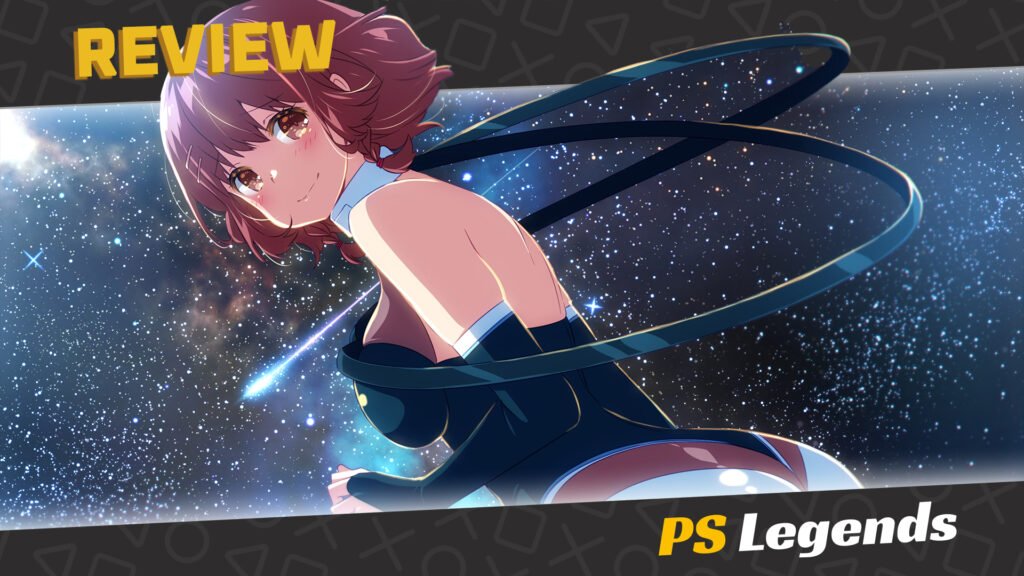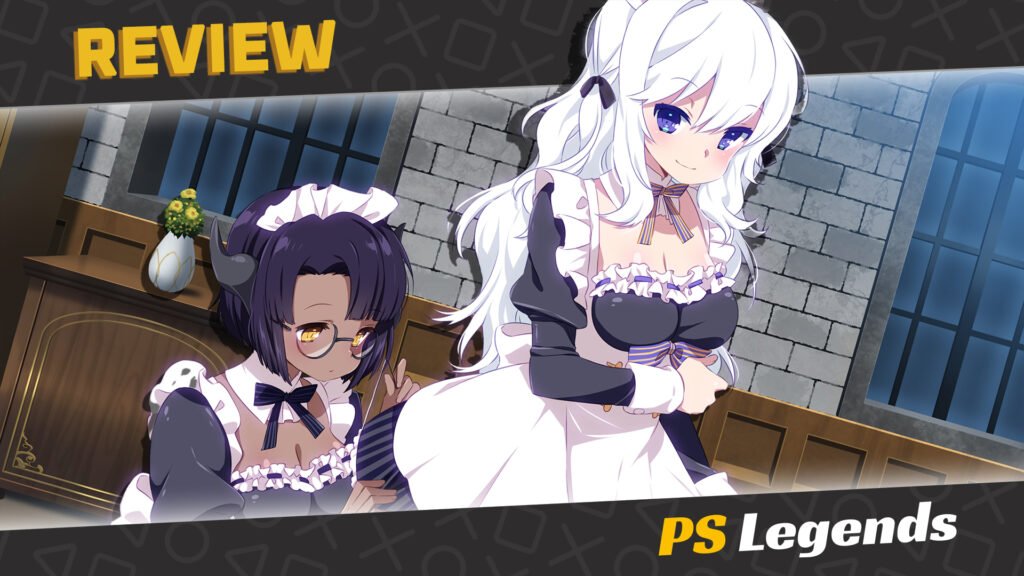Before we begin, I think we’re long overdue a discussion regarding the subject of game development time. It has become very easy to criticise many game developers for not giving their respective games the time and attention they deserve. The terms ‘annual update’ and ‘yearly cash-in’ are frequently being used to describe such games, and with very good reason.
However, there are always developers who do give their games the love and dedication that they deserve, taking their time to deliver a polished, finished product. Then, there are developers who take it to extremes and spend half of a console’s lifespan producing a single game. Therefore, can games spend too long in development? It would certainly seem so if developers produce unsatisfactory results when compared to others who deliver better games in shorter timescales.
I’m going to pick on Square-Enix first, who learned the hard way that a longer development does not make a better game. Final Fantasy XIII spent a total of 6 years in development, and yet was heavily criticised (and rightly so) for poorly balanced, over-complicated gameplay. Its sequel, Final Fantasy XIII-2, was completed in just 12 months and was praised for its less linear gameplay, its more believable and accessible game world, and its more forgiving combat. Despite sacrificing lengthy video sequences, it was clearly the better game overall.
Introduction
This brings us to Irrational Games’ BioShock Infinite, which began development during BioShock 2‘s production at the hands of sister-studio 2K Marin. Infinite was announced along with an unconfirmed March 2012 release date, which then slipped to a confirmed May 2012 release. Of course, it didn’t happen. BioShock Infinite re-entered development to include a possible multiplayer option, a feature which received mixed reviews in BioShock 2.
In early 2013, Irrational Games’ (formerly 2K Boston) lead designer Ken Levine announced that multiplayer was being dropped from BioShock Infinite as it was ‘unnecessary’ to the overall narrative. He was absolutely right, but a whole year had now been wasted with the game trapped in development limbo. It was finally released in its ‘complete’ yet single-player-only state on March 28th 2013.
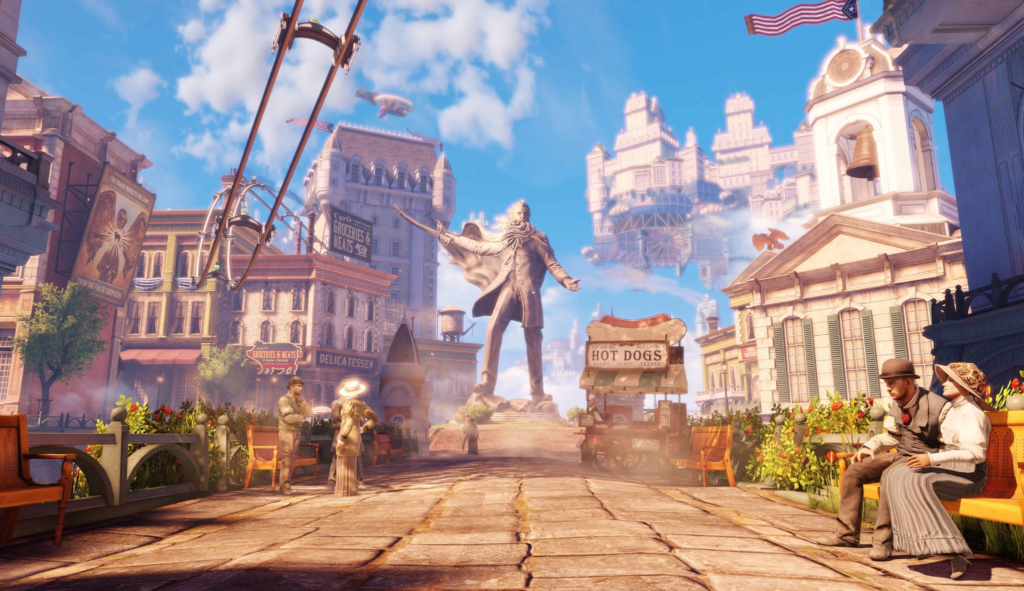
Story
Inspired by the 1893 World’s Fair, BioShock Infinite is set in 1912 during the growth of American Exceptionalism. The game’s protagonist, former Pinkerton agent turned private investigator Booker DeWitt, is sent to the floating air-city of Columbia to find a young woman, Elizabeth, who has been held captive there in a high-security tower for the last twelve years.
Though Booker soon rescues Elizabeth from the giant mechanical ‘Songbird’, the two are pursued by the city’s warring factions; the native and elitist Founders who strive to keep the city for ‘pure’ Americans, and the Vox Populi, a rebel group representing an alliance of the underclasses. Booker finds Elizabeth to be central to this conflict, and that she also holds strange powers enabling her to manipulate rifts in the space-time continuum that ravage Columbia. Booker’s relationship with Elizabeth quickly grows into a juxtaposition of friendship and fear until it all suddenly ends in a rather unsatisfying way.

Gameplay
The player controls Booker throughout the game, eventually working with the AI-controlled Elizabeth. Like previous BioShock games, the player uses a combination of weapons, gadgets, psychokinetic powers granted through ‘Vigors’, as well as Elizabeth’s own powers to fight off hostile foes and make their way through Columbia. BioShock Infinite is a first-person shooter with some minor role-playing elements. Infinite adapts the gameplay formula of BioShock, with weapons, powers, and upgrades often functioning similarly to those in the earlier games, albeit named differently.
In contrast to the limited spaces of the underwater city of Rapture, the open-air city of Columbia provides for more combat challenges, including shootouts which take place aboard the city’s Sky-Line roller-coaster-like rail system. This gives the game’s difficulty a noteworthy and unexpected increase, yet also opens up more combat options for experimental players. The city is generally traversed on foot or via the Sky-Line, via special magnetic hooks. Booker can jump on, off, and between Sky-Line tracks at any time and fire one-handed weapons while riding them. The hook also serves as a melee weapon, capable of performing finisher moves on weakened foes.
Booker may carry only two weapons at a time, and can collect other weapons and ammunition from defeated enemies or the environment. In addition to guns and melee attacks, the player can use superpower-bestowing Vigors; these include the ability to shoot lightning, disable enemies by launching them into the air, or by controlling enemies or machines. Vigors require depletable Salt to power the abilities. The player is opposed by enemies representing the Founders and the Vox Populi. These foes range from normal infantry types to more formidable enemies that act as mini-bosses throughout the game. Armed automatons scattered throughout Columbia act as a security defense system for the city.
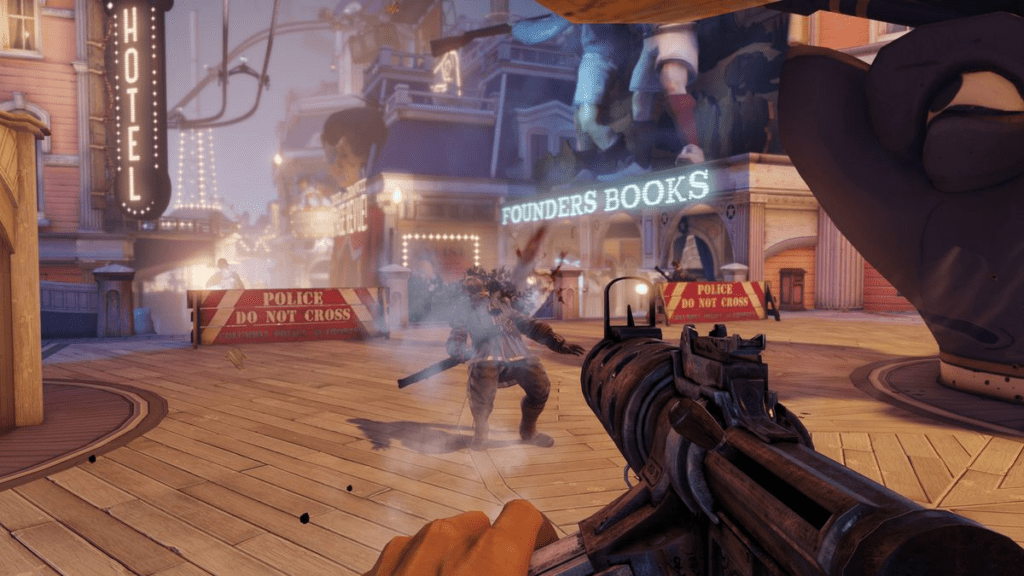
Booker has a health meter and a damage-absorbing shield; the shield automatically regenerates outside of combat, while health must be replenished with medical kits and/or food. If Booker dies, he revives in a safe area at the cost of money, while local enemies are also partially healed. Items called ‘Gear’ grant passive abilities that can improve Booker’s strength or damage resistance. A piece of Gear attaches to one of four slots; only one piece of Gear can be affixed to a slot at a time, with extras stored in the player’s inventory. Attributes can also be improved by finding Infusions, which upgrade the Health, Shield, or Salt meters.
Booker is aided throughout the game by Elizabeth, an AI-controlled character. Elizabeth requires no protection and assists during combat by tossing helpful items to Booker as needed. She can also be directed to open Tears, bringing in items or pieces of the environment, such as medical kits or cover. Elizabeth can pick locks using hairpins to open doors or find useful items. Cash, food, medical kits, ammunition and Salts can be found scattered throughout the game’s environments. Vending machines can be used to buy supplies and upgrades for weapons and Vigors.

Graphics/Sound
BioShock Infinite uses a very similar graphics engine to that which featured in BioShock and BioShock 2, so it’s really starting to show its age. Environments look as visually stunning as they always have, yet the engine clearly wasn’t designed with detailed character models in mind. The original game hid this well, with minimal lighting and very few scenes of face-to-face character interaction, yet its sequels placed more focus on such scenes rather than using the Metal Gear Solid-inspired codec-like radio for communication.
Characters lack that next-gen (at the time) detail, being comparable to the soulless, cartoony characters from the likes of Fable 3. BioShock Infinite falls into this trap, and arguably looks worse with its brightly lit, outdoor gameplay elements. Perhaps it would be more forgivable if the game was released when it was initially completed but we should expect more from a AAA title from a respected developer. The least detailed character is the one who appears the most too, our leading lady, Elizabeth.
It’s so very odd that certain characters look so much better than others. The Lutece twins, who’ll be Booker’s eccentric allies throughout the journey, have a beautiful, photo-realistic quality to them, while Elizabeth and nemesis Comstock have overly-basic ragdoll-like features and motions.
Fortunately, the voice cast is genuinely superb, with Troy Baker’s performance as Booker DeWitt, Courtnee Draper’s Elizabeth and Jennifer Hale as Rosalind Lutece being particularly praiseworthy. The crackle of vinyl audio present in parts of the soundtrack brings a charming authenticity to the tunes. The brass-heavy music is so peppy that it’s actually appropriately creepy, yet it can also be so annoyingly loud that it’s distracting.
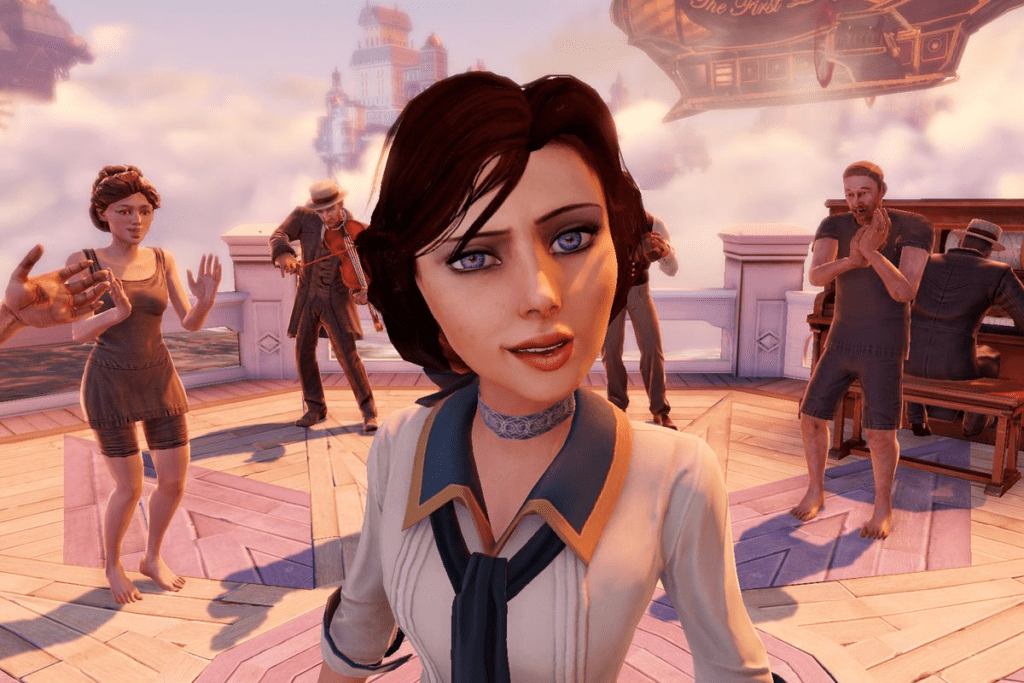
Replayability/Trophies
Optional side-missions are available, where the player must unlock safes or decode hidden ciphers; completing them rewards Booker with supplies and upgrades. Voxophones (audio logs) and Kinetoscopes (film projectors) scattered throughout Columbia expand on some key characters and events of the game. These are all missable, with the linearity of the story meaning even the most open and accessible environments will eventually reach a point of no return.
Seeing, finding and interacting with absolutely everything is key in grabbing the platinum trophy, meaning a guide is essential here. The rewards for experimenting with alternative styles of gameplay, such as setting traps, using the environment to your advantage or summoning support from Elizabeth often grants the player with a trophy or two and can make subsequent playthroughs feel more rewarding, meaning you could even enjoy your second playthrough more than your first.
BioShock Infinite has four difficulty levels: Easy, Normal, and Hard difficulties are available to start. After beating the game on a lower difficulty level or inputting the ‘Konami Code’ in the main menu, the hardest ‘1999 Mode’ is unlocked. Enemies are much tougher, the player’s navigational aid and aim assist is removed, resource management is much more crucial to survival, and death is more punishing.
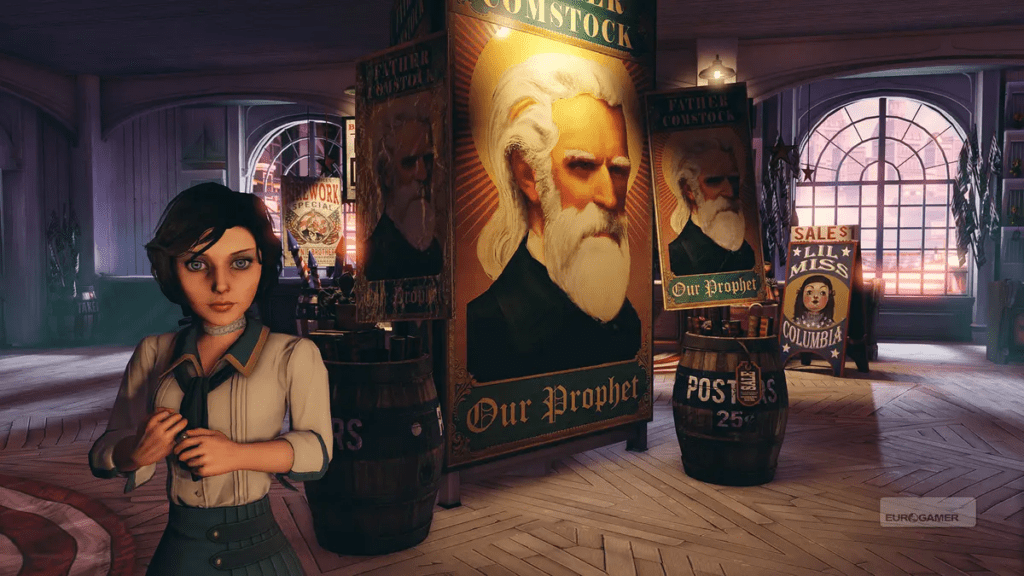
Conclusion
Has the delay damaged the game? Mechanically no, but technically yes. We’re talking about a big-budget title that was starting to look old even on release. Puppet-like character graphics aren’t everything though and there are many other elements which define a game, elements which BioShock Infinite delivers with varying levels of success, such as the concept and storyline.
Whilst the game opens with a stab at moral choices in the form of optional racism, this is quickly forgotten about. In fact, nothing you do in BioShock Infinite will change your outcome, and when it’s all over you’ll suddenly realise that you’ve achieved absolutely nothing. The game later introduces the concept of multiple realities, each different from the last; there’s also a sort of unpredictable time-travel in play too. These concepts, while usually interesting, have all been done before, and with far greater success in countless other narratives.
Need to acquire an item for someone? When the game switches dimensions on you and the NPC you’re helping is now dead, your efforts up to that point could be considered a waste of time. Your friends may become your enemies and your old enemies may have already been killed. Yes, it’s all terribly confusing until the ending wraps it up for you, but since you end up pretty much exactly where you started, everything you do is ultimately pointless.
BioShock Infinite is incredibly unfulfilling, lacks real closure and is a genuine chore to play through at times. It feels like one chapter of a much grander multiverse; a multiverse we’ll likely never get to see in anything close to its entirety. This also means that, like BioShock 2, the paid DLC is a core component, filling in plot holes which really should be addressed during the main game. I would also argue that the more streamlined and story-focused DLC is actually better than the base game.
This makes for an experience composed of solid gunplay softening sluggish shootouts in between story scenes. The out of place, magic-like Vigors feel largely tacked-on to make the game handle like its predecessors, and their inclusion won’t be explained until you invest in the DLC. It’s not bad, but the mixed bag of characters and unrewarding, fragmented story make BioShock Infinite one of the biggest disappointments of its time.
Joys
- Beautiful environments
- Strategic gameplay variety helps replayability
- Fun area traversal systems aid progression
Cons
- Patchy, uneventful core story with an ending that feels unfinished
- Some ugly character models
- Far more linear than it pretends to be

